This temple reminded me of my mom, and her monthly trips to Lipa.
When I was a kid, we attended mass only during the holiest days of obligation. I asked my parents why that was, and they said that they worshipped God in their own quiet way. If I remember correctly, it wasn’t until my grandmother became terminally ill that my mother started going to Sunday mass.
Perhaps out of desperation to see her health improve, she started visiting Mt. Carmel Church in Lipa to pray for her recovery. She promised that she would return every month no matter how my grandmother’s health progressed. My grandma eventually passed away, but my mom kept good on her promise and continues to make her monthly pilgrimages to Batangas, even to this day.
In desperate pursuit of a wish, this must be how those 234 people felt when they jumped off and plummeted thirteen meters (43 feet) from the veranda of Kiyomizu-dera’s main hall. Of those 234 recorded jumpers, 34 died. The surviving 200, if legend were to keep good on its promise, would see their wishes granted. Risking death in return for a blessing, this leap of faith led to the popular expression “to jump off the stage at Kiyomizu“, which is the Japanese equivalent of the English expression “to take the plunge”.
Like throwing a coin into a fountain or rubbing Buddha’s belly for good luck, I always enjoy making wishes wherever, and however, I can. Luckily for me, there were plenty of other available options here.
Kiyomizu-dera
Walking up the hill towards the temple. According to my Japanese friend Tom, the kanji on the left says “Kiyomizu-dera”. Taking its name from the waterfall within the complex, kiyomizu means “pure water”. Dera is the Japanese word for Buddhist temple.

Climbing up the stairs, you’re greeted by the Deva Gate, which is the main entrance to the complex. One of Kyoto’s most popular attractions, Kiyomizu-dera is a UNESCO World Heritage Site.
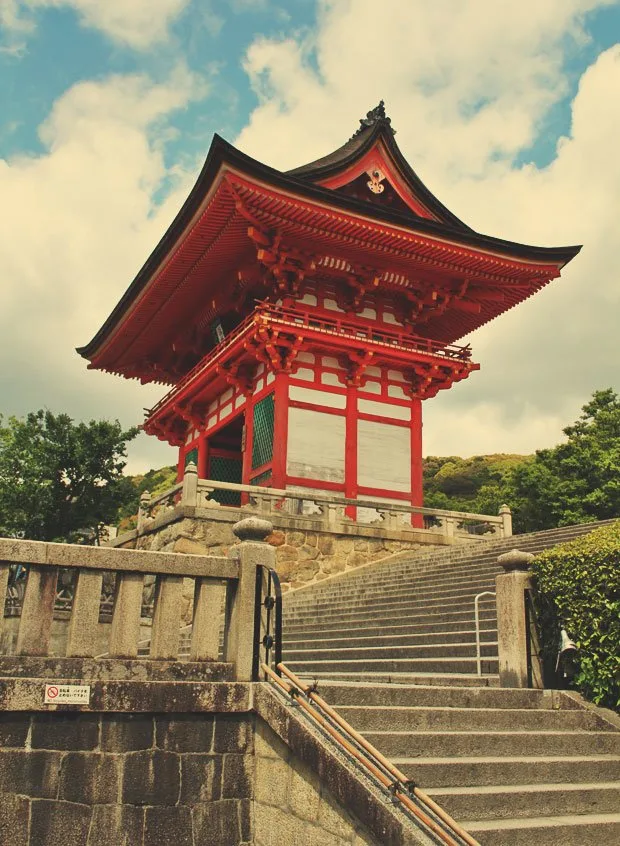
Admiring the colors and details
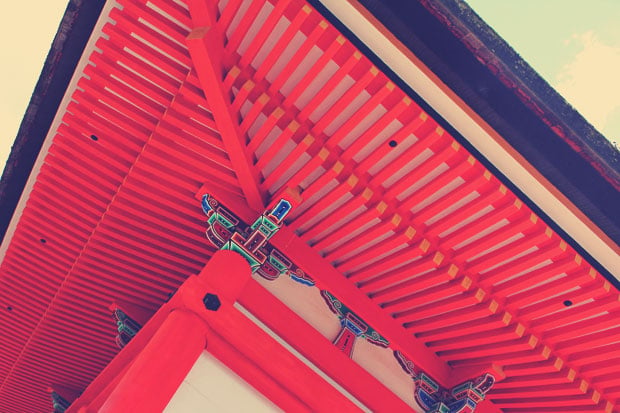
Koyasu Pagoda in the distance. A visit to this three-storied pagoda is said to grant your wish of an easy and safe childbirth. None of us were pregnant so we skipped this. These hills are said to be stunning during cherry blossom season or the fall.
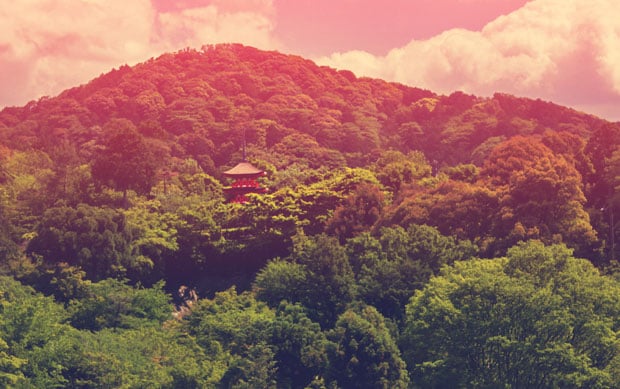
Still admiring the details
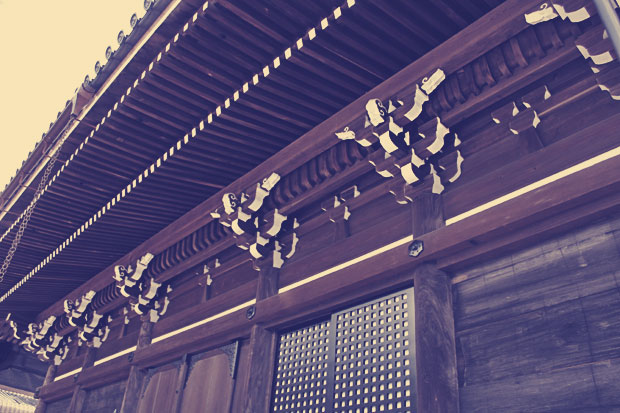
The aforementioned thirteen meter high main hall, built without the use of a single nail. Popular during the Edo period, jumping off the veranda is apparently no longer allowed. I wonder why. 😆
During the spring and fall, you can visit the temple at night to see it fully lit. Must be magical.
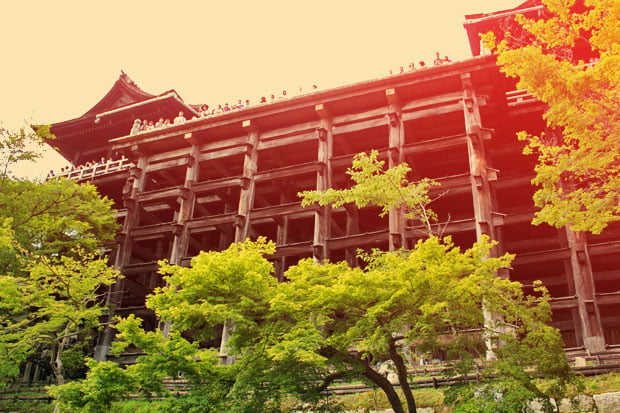
Thick ropes attached to gongs. Not sure what these were for, but I think they had something to do with wishmaking. Seems to be a common thread here. 😉
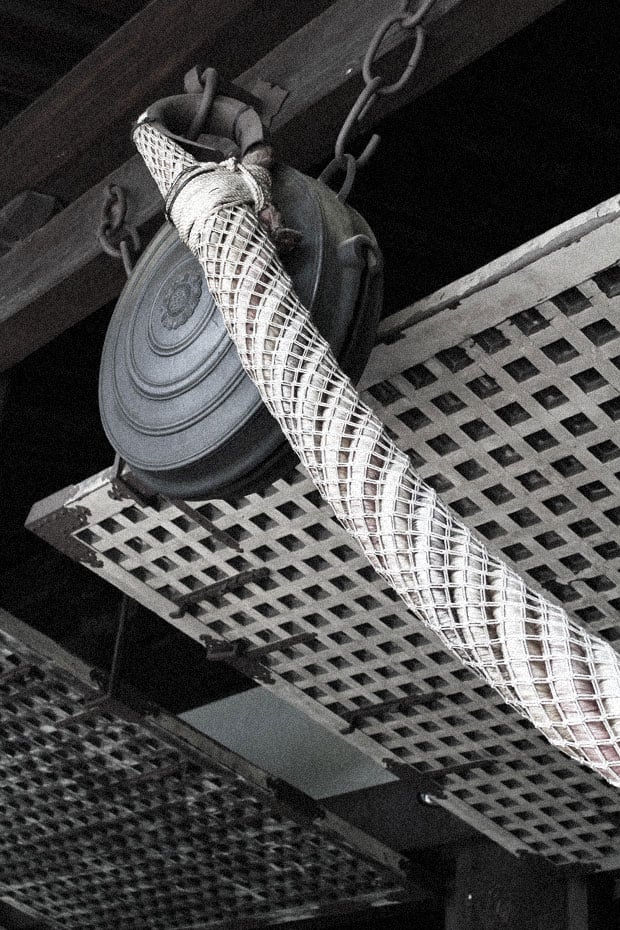
Speaking of wishmaking, there’s me on my knees tapping on the giant cauldron while saying a short prayer. I remember exactly what I wished for too: “Health, wealth, and happiness for all my loved ones, more kindness learned for me.” Aaaawwww… 😆
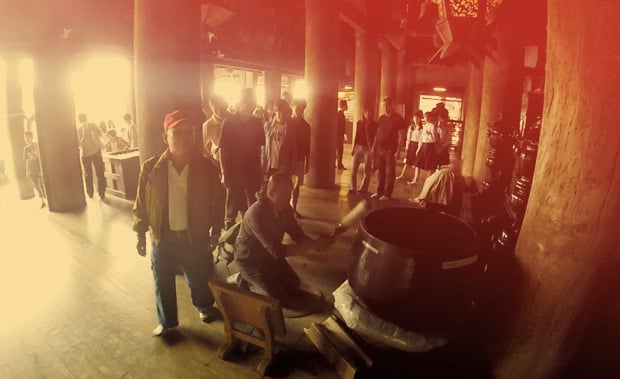
The waterfall from whence this temple derives its name. Located at the base of the main hall, the Otowa Waterfall is divided into three separate streams. Drinking from each stream is said to provide a different wish-granting benefit. The first is for longevity, the second for success at school, and the third for luck in love. A word of caution: Drinking from all three is considered greedy, so don’t do it. 😉
Winding up our day of wishmaking, we took Ninen-zaka and Sannen-zaka streets back down towards the bus stop. These are quaint, flagstone-lined streets with traditional wooden shops and teahouses on either side. It’s a great place to window shop and soak up the Kyoto atmosphere.
Kiyomizu-dera Temple
294 Kiyomizu 1-chome, Higashiyama Ward, Kyoto, Kyoto Prefecture 605-0862, Japan
Tel: +81 75-551-1234
Website: kiyomizudera.or.jp
Operating Hours: Mon-Sun, 6AM-6PM / 6:30PM-9:30PM (Spring and fall illumination)
Admission: ¥400 (Kiyomizu-dera Temple) / ¥400 (Spring and fall illumination)
Suggested Length of Visit: 2-3 hours
HOW TO GET THERE:
From Kyoto Station, take bus number 100 or 206 (15 minutes, ¥230) and get off at Gojo-zaka or Kiyomizu-michi bus stop. The temple is about a 10-minute uphill walk from there. CLICK HERE for more information.

Marc
Monday 23rd of January 2017
I love kiyomizu dera temple. Omamori of this temple is aivalable ... I hope one day to return to Japan
Joanna
Thursday 22nd of September 2016
Thank you for your blog. Certainly the friendliest and comprehensive discussion on very important must knows for 1st timers, prepared in a condensed way. Congratulations!
May i consult you regarding the practicality of getting to visit Nara from Kyoto to vist the deer park, is it worth it?
As well, how best to leverage on bike rentals for the full day when commute needs to happen through trains and buses - will it be allowed inside ? or can rent bikes from the sites itself?
Thank you in advance.
JB & Renée
Thursday 22nd of September 2016
Hi Joanna, happy you found the guides useful. :) We didn't go to Nara so I can't tell you from experience, but a day trip to Nara would be a good idea based on what other travelers have said. It's a quick train ride away from either Kyoto or Osaka. We didn't rent bicycles either but I do remember seeing bike rental shops at various sites. Not sure on price but it would definitely be easier to just rent bikes at each location. Have an awesome time in Japan!
JB & Renée
Sunday 6th of July 2014
Indeed it is AP. I'm sure the place is pure magic during fall or cherry blossom season, especially during evening illumination. :)
Anonymous Paul
Sunday 6th of July 2014
Definitely a Kyoto highlight. If you only have time for one temple in Kyoto, I would suggest going here. The walk up alone is so interesting. Quite beautiful I would assume during cherry blossom season where surrounding area turns pink. And during fall when leaves turn orange.